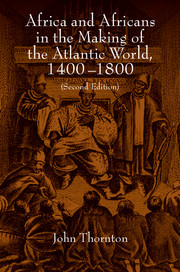Book contents
- Frontmatter
- Contents
- Preface to the second edition
- Abbreviations
- Maps
- Source notes for Maps 1–3
- Africa and Africans in the making of the Atlantic world, 1400–1800
- Introduction
- Part I Africans in Africa
- 1 The birth of an Atlantic world
- 2 The development of commerce between Europeans and Africans
- 3 Slavery and African social structure
- 4 The process of enslavement and the slave trade
- Part II Africans in the New World
- Index
3 - Slavery and African social structure
Published online by Cambridge University Press: 05 June 2012
- Frontmatter
- Contents
- Preface to the second edition
- Abbreviations
- Maps
- Source notes for Maps 1–3
- Africa and Africans in the making of the Atlantic world, 1400–1800
- Introduction
- Part I Africans in Africa
- 1 The birth of an Atlantic world
- 2 The development of commerce between Europeans and Africans
- 3 Slavery and African social structure
- 4 The process of enslavement and the slave trade
- Part II Africans in the New World
- Index
Summary
If Africans were experienced traders and were not somehow dominated by European merchants due to European market control or some superiority in manufacturing or trading techniques, then we can say confidently that Africa's commercial relationship with Europe was not unlike international trade anywhere in the world of the period. But historians have balked at this conclusion because they believe that the slave trade, which was an important branch of Afro-European commerce from the beginning, should not be viewed as a simple commodity exchange. After all, slaves are also a source bf labor, and at least to some extent, their removal from Africa represented a major loss to Africa. The sale of slaves must therefore have been harmful to Africa, and African decisions to sell must have been forced or involuntary for one or more reasons.
The idea of the slave trade as a harmful commerce is especially supported by the work of historical demographers. Most who have studied the question of the demographic consequences of the trade have reached broad agreement that the trade was demographically damaging from a fairly early period, especially when examined from a local or regional (as opposed to a continental) perspective. In addition to the net demographic drain, which began early in some areas (like Angola), the loss of adult males had potentially damaging impacts on sex ratios, dependency rates, and perhaps the sexual division of labor.
- Type
- Chapter
- Information
- Publisher: Cambridge University PressPrint publication year: 1998
- 2
- Cited by



